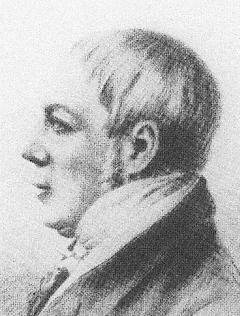William Hedley facts for kids
Quick facts for kids
William Hedley
|
|
|---|---|
 |
|
| Born | 13 July 1779 Newburn, England
|
| Died | 9 January 1843 (aged 63) |
| Nationality | British |
| Occupation | Colliery viewer |
William Hedley was an important engineer born in Newburn, England, in 1779. He helped create some of the first successful railways. As a manager at Wylam Colliery, he built a special steam locomotive. This engine was unique because it used the grip, or adhesion, of its iron wheels on iron rails to move. This was a big step forward for early railways.
Contents
Early Steam Engines on Rails
Before William Hedley, steam engines were often too heavy for the railway tracks. Most railways used ropes pulled by stationary engines. Other ideas were tried, but they often didn't work well.
For example, in 1812, William Chapman tried an engine that pulled itself along a cable. Another engineer, Brunton, made a less successful machine called the "Steam Horse."
However, in 1812, Matthew Murray and John Blenkinsop built the first steam engine with two cylinders. It was called Salamanca. This engine ran on the Middleton Railway near Leeds. It used a special gear that connected to teeth on the track. This was the first successful steam railway, but it was complicated and costly.
Hedley's Smart Ideas
Building the First Engine
William Hedley believed that if an engine's wheels were connected, like on Richard Trevithick's designs, they would grip the track better. If one wheel started to slip, the others would help.
The mine owner, Christopher Blackett, had just put in new iron tracks. Hedley first built a test cart that people pushed. He used it to see how much grip the wheels had with different weights.
Then, he used this cart as the base for a new steam engine. It had one cylinder and a simple boiler. But this first engine didn't work very well. It moved unevenly and didn't make enough steam.
The Famous Puffing Billy
Hedley didn't give up! He built a second, much better engine. He had help from Timothy Hackworth, his skilled foreman, and Jonathan Forster, his main engine builder. They used the two-cylinder design from Blenkinsop and Murray. They also added a special boiler that made more steam.
This new engine was the famous Puffing Billy. It first ran in 1813 and was a big success! Today, you can see Puffing Billy at the Science Museum in London.
Because Puffing Billy worked so well, they built a second engine called Wylam Dilly. This engine is now at the National Museum of Scotland in Edinburgh. In the same year, Hedley received a patent for his system of connecting the wheels.
Making Them Even Better
Even with these great engines, the heavy weight still caused a lot of wear on the tracks. So, the engines were rebuilt with two sets of four wheels, called bogies. This helped spread out the weight.
Around 1830, the railway line was upgraded with stronger tracks. Both Puffing Billy and Wylam Dilly were changed back to their original design, but with flanged wheels. They worked actively until 1862, showing how well Hedley's ideas performed!
William Hedley's Legacy
William Hedley passed away in 1843. He was buried at Newburn parish church. His four sons continued to work in the coal-mining industry. His family remained involved until the mines were taken over by the government in the 1940s. In 1971, a charity was started in Hedley's name, using money from that time.

